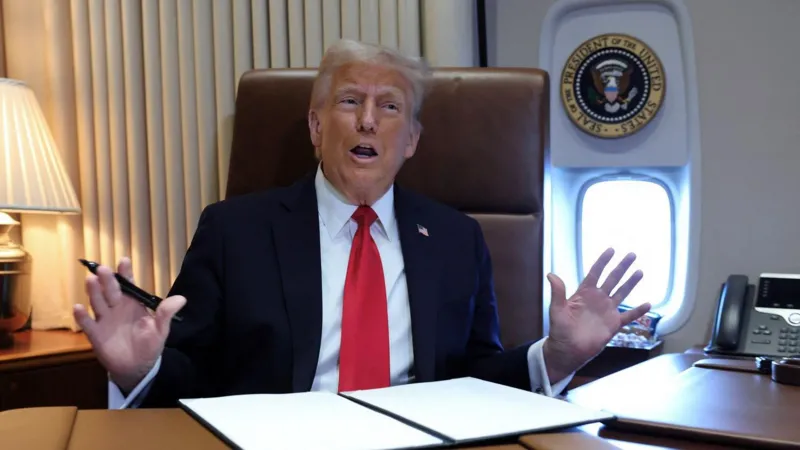Former U.S. President Donald Trump has announced plans to impose a sweeping 25% import tax on all steel and aluminium entering the United States. The move, which Trump revealed while en route from his Mar-a-Lago resort in Florida to the Super Bowl in New Orleans on Sunday, is expected to have significant repercussions for key trading partners, particularly Canada and Mexico.
Trump’s latest tariff announcement signals a return to the aggressive trade policies that defined his first term, where he imposed similar duties on steel and aluminium imports from Canada, Mexico, and the European Union. While those tariffs were lifted for Canada and Mexico in 2019 following bilateral negotiations, Trump’s new proposal threatens to reignite trade tensions with U.S. allies.
“If they charge us, we charge them,” Trump declared, emphasizing his vision of reciprocal trade policies aimed at protecting American industries.
Canada, the largest supplier of aluminium to the U.S., is expected to feel the brunt of these new tariffs. Ontario Premier Doug Ford swiftly criticized Trump’s announcement, accusing him of creating “constant chaos” and jeopardizing the economic stability of North America. Ontario is home to the bulk of Canada’s steel production, making it highly vulnerable to these policy shifts.
Mexico, another major U.S. trading partner, has yet to issue an official response. However, the potential reintroduction of tariffs could strain the United States-Mexico-Canada Agreement (USMCA), which was designed to facilitate free trade across North America following the renegotiation of NAFTA during Trump’s first term.
Trump’s announcement has sent shockwaves beyond North America. South Korean steel and automobile manufacturers saw a decline in stock prices following the news. As a major steel exporter to the U.S., South Korea had previously negotiated partial exemptions from Trump-era tariffs, but the new blanket policy threatens to reverse those agreements.
In Australia, Prime Minister Anthony Albanese vowed to advocate for an exemption similar to the one Australia secured during Trump’s previous administration. “We will make the case to the U.S. for Australia to be exempt,” Albanese told parliament, noting that he has a scheduled meeting with the U.S. president to discuss the matter.
Interestingly, shares of BlueScope, Australia’s largest steel producer, rose by 1.6% despite the looming threat of tariffs. The company’s strong presence in Ohio, where it operates the North Star Mill, may offer some insulation from the policy’s immediate effects.
Tariffs have long been a cornerstone of Trump’s economic strategy. He argues that import duties protect American jobs, stimulate domestic production, and generate revenue for the federal government. In recent weeks, Trump has also threatened to impose a 25% duty on Canadian and Mexican products, though he delayed implementation after discussions with both countries’ leaders.
In addition to targeting North American partners, Trump has escalated trade tensions with China. Earlier this month, he announced a new 10% tariff on all Chinese goods entering the U.S., prompting swift retaliation from Beijing with their own set of tariffs.
Trump hinted at further announcements this week, stating that more reciprocal tariffs would be unveiled on “Tuesday or Wednesday” and would take effect “almost immediately.” This tit-for-tat approach reflects Trump’s belief in aggressive trade negotiations, where economic leverage is used to force favorable terms for the U.S.
“The ones that are taking advantage of the United States, we’re going to have reciprocal [tariffs]. It’ll be great for everybody, including other countries,” Trump asserted confidently.
During his flight to New Orleans, Trump signed a proclamation declaring February 9 as “Gulf of America Day,” in honor of his executive order to rename the Gulf of Mexico. This symbolic gesture has sparked outrage in Mexico, where officials argue that international law, particularly United Nations maritime rules, prevents unilateral name changes of shared bodies of water.
Trump also made controversial remarks about Canada and the Gaza Strip, suggesting that the U.S. could “take over” both regions. Referring to Canada as a potential “51st state,” Trump claimed that the country would thrive under U.S. governance. He further stated that he was “committed to buying and owning Gaza,” remarks that have drawn criticism for their insensitivity amid ongoing geopolitical tensions in the Middle East.
When asked about his communications with Russian President Vladimir Putin, Trump was evasive, saying, “I don’t want to talk about it, and if we are talking, I don’t want to tell you about the conversations too early.” However, he hinted at a possible future meeting with Putin, claiming that the timing would be “appropriate.”
Trump’s tariff announcements are expected to send ripples through global markets, with industries bracing for increased costs and potential supply chain disruptions. Economists warn that escalating trade wars could lead to higher prices for consumers, strained diplomatic relations, and volatility in international markets.
As Trump prepares to formalize these tariffs, the world will be watching closely to see how U.S. allies and trading partners respond. With reciprocal tariffs and legal challenges likely on the horizon, the global economy may be entering another period of uncertainty driven by Trump’s bold, confrontational trade policies.
Stay ahead with the latest news on global innovation, leadership, entrepreneurship, business, and tech. Join us on WhatsApp or Telegram for real-time updates. Have a report or article? Send it to report@theinnovationtimes.com.
Follow us on X (Twitter), Instagram, LinkedIn, Pinterest and Facebook for more insights and trends



